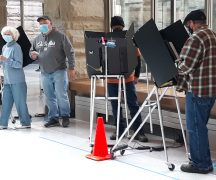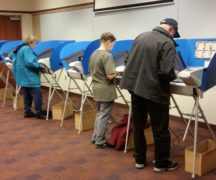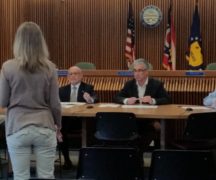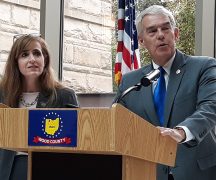By JAN LARSON McLAUGHLIN
BG Independent News
If Ohio legislators thought they would sneak a state issue past snoozing voters over a sleepy summer election, they were in for a rude awakening on Tuesday.
And once riled to defend their right to citizen-initiated constitutional amendments, it’s unlikely the electorate will sit back while their reproductive rights are in question this November.
“I’m not surprised,” said Katelyn Elliott, secretary with the League of Women Voters in Bowling Green. “I was confident the people of Ohio would not give up the rights we’ve had for more than 100 years.”
The Associated Press projected the failure of Issue 1 around 9 p.m. At that point, the votes opposing Issue 1 were leading 59% to 41% with about half of the vote counted, according to unofficial results.
Wood County’s numbers were similarly split. Voting “no” were 14,746 (59.6%), and voting yes were 10,000 (40.4%), according to unofficial counts when 88 of 99 precincts were in.
The statewide issue garnered the interest and ire of many local voters. In Wood County, where August elections usually bring out just 7% of local registered voters, 27% of voters showed up to voice their opinions on Issue 1.
Early voting numbers were strong in the county. By Monday morning, 6,694 voters had shown up in person, while another 2,068 had mailed in their ballots.
“Yes, it’s high,” Wood County Board of Elections Deputy Director Terry Burton said. “But you can’t compare this number to anything. We’ve not had a statewide issue like this in modern memory.”
If it had passed, Issue 1 would have required 60% support to pass any future citizen-initiated amendment to the state constitution. The issue would also have required petitioners to collect a certain number of signatures in all 88 counties – well above the 44 counties required now.
The defeat of Issue 1 speaks loudly to Bowling Green City Council President Mark Hollenbaugh.
“It doesn’t matter who’s financing campaigns, Ohio citizens really do respect and appreciate their freedom and they don’t want anyone to take that away from them,” Hollenbaugh said, as he waited for the numbers to come in Tuesday evening. “This is making me feel pretty good about democracy.”
Bowling Green City Council member Jeff Dennis said the defeat of Issue 1 showed widespread bipartisan rejection of the issue.
“There’s not a long list of things that Gov. Taft, Betty Montgomery and I agree on,” said Dennis, a Democrat. Despite overwhelming GOP support in the legislature, former state officials and citizens of both parties recognized Issue 1 as a threat to democracy.
“It would have effectively ended citizens’ initiatives in Ohio,” Dennis said. “It was against citizens’ rights.”
Lee McLaird, president of the League of Women Voters in Bowling Green, said the league fulfilled its role of educating voters.
“We were providing information to the public of what the law would do,” McLaird said. “We are all quite pleased it was defeated. Democracy is one person, one vote. This was going to make that extremely hard to do.”
Over the past few months, Wood County had some strong voices in the Issue 1 fight.
State Sen. Theresa Gavarone, R-Bowling Green, was a sponsor of the bill. Though she had fought in 2022 to discontinue any statewide ballot issues in August because of low voter turnout, Gavarone later defended placing Issue 1 in the special election.
Gavarone said her motive for Issue 1 was to ensure that well-funded, out-of-state special interests no longer have the ability to manipulate Ohio’s Constitution. That argument, however, was criticized for its hypocrisy since Issue 1 was openly funded by a billionaire from Illinois.
Gavarone said the Ohio Constitution is too easy to change, having undergone 174 changes. She failed to note that only 19 of those changes, over 100 years, were from citizen-initiated ballot measures. The rest were by legislators.
“Should Issue 1 fail, radical and rich special interests from outside Ohio will come in and impose their will. In a few short years, our beloved state could look more like California, New York, New Jersey or Illinois,” Gavarone warned before the election.
Opposition to Issue 1 came from some unlikely voices of former governors and attorneys general from both parties. One of the strongest was Betty Montgomery, former Republican state attorney general and former state senator representing Wood County.
“There is so much about Issue 1 that is anti-democratic,” Montgomery said.
Montgomery was concerned about the issue being decided during an August election, which have traditionally low voter turnout, the new signature requirements that go far beyond any other state’s requirements, and the hypocrisy of using special interest money to fund an issue that is being presented as a way of stopping special interests in Ohio.
She said Ohio already has reasonable safeguards in place for citizen proposed amendments. In the last 110 years, citizens have proposed 71 amendments. Just 19 of those passed with the current standard of 50% plus one vote to win.
Montgomery also said the real purpose behind Issue 1 is state control over reproductive rights and redistricting. The new requirements would have made it very difficult for voters to ensure reproductive rights, and to continue the quest for redistricting, she added.





